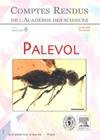波兰南部Cianowice 2钻孔中侏罗世植物组合的大、微花区系变化
IF 1.3
4区 地球科学
Q3 PALEONTOLOGY
引用次数: 1
摘要
波兰克拉科夫(Cracow)西北约20 km的Cianowice 2钻孔植物区系以苏木类(主要为贝尼蒂塔科)和针叶树类为主,具有较高的分类多样性和较少的标本数量。在27个核心样品中发现的96个可确定的植物片段中鉴定出20个物种:Cladophlebis sp.(蕨类),Pachypteris rhomboidalis (Ettingshausen) Nathorst和Ptilozamites cycadea (Berger) Möller(种子蕨类),Anomozamites nilssonii (Phillips) Seward, nilsoniopteris solitaria (Phillips) Cleal & Rees, Otozamites mimetes Harris, Otozamites parallelus Phillips, Pterophyllum . tomasii Harris, Pterophyllum . aequale (Brongniart) Nathorst, ptilophylum f.k ribense forma ratchiana Doludenko & Svanidze, ptilophylum pecten Phillips, ptilophylum sirkennethii Watson & Sincock,cycadolepia sp. (bennettitaleans), pseudotorelia grojecensis Reymanówna, pseudotorelia samylinae Nosova & Kiritchkova, pseudotorelia sp.(裸子植物),Bilsdalea dura Harris, Mirovia szaferi Reymanówna和Brachyphyllum stemonium Kendall(针叶树)。植物区系组成由孢粉学资料补充。该分类群与沿岩心划分的五个沉积序列有关:一是冲积扇;二、四、五、曲流/吻合河沉积体系与河流平原沉积;三是河流平原上发育湖泊/沼泽环境。在同一分类群范围内,化石植物组合的组成随沉积环境的变化而变化,主要表现在分类群组合的变化上,在河流平原沉积中最具多样性。有些分类群发生在单一的沉积演替中;有些是两三个出现。特定沉积环境的孢子形态组合与共生大区系的组成存在显著差异:蕨类植物在每个沉积环境的大区系中零星出现,但它们在孢子形态组合中占主导地位。我们提出的古环境重建是一个轻微的上升,下降到一个带有沉积盆地的山谷,裸子植物生长在斜坡上,蕨类植物生长在底部。一些物种在Cianowice和Grojec和Zabierzów附近的中侏罗世地区共享,大多数分类群来自中侏罗世,这表明Cianowice矿床属于那个时代。本文章由计算机程序翻译,如有差异,请以英文原文为准。
Macrofloral and microfloral changes in the Middle Jurassic plant assemblages of the Cianowice 2 borehole (southern Poland)
The flora of the Cianowice 2 borehole (c. 20 km NW of Cracow, Poland), dominated by cycadophytes (mainly bennettitaleans) and conifers, shows high taxonomic diversity relative to the low number of specimens. Twenty species were identified in the 96 determinable plant fragments found in 27 core samples: Cladophlebis sp. (ferns), Pachypteris rhomboidalis (Ettingshausen) Nathorst and Ptilozamites cycadea (Berger) Möller (seed ferns), Anomozamites nilssonii (Phillips) Seward, Nilssoniopteris solitaria (Phillips) Cleal & Rees, Otozamites mimetes Harris, Otozamites parallelus Phillips, Pterophyllum thomasii Harris, Pterophyllum cf. aequale (Brongniart) Nathorst, Ptilophyllum cf. okribense forma ratchiana Doludenko & Svanidze, Ptilophyllum pecten Phillips, Ptilophyllum sirkennethii Watson & Sincock, Cycadolepis sp. (bennettitaleans), Pseudotorellia grojecensis Reymanówna, Pseudotorellia samylinae Nosova & Kiritchkova, Pseudotorellia sp. (Gymnospermae incertae sedis), Bilsdalea dura Harris, Mirovia szaferi Reymanówna, and Brachyphyllum stemonium Kendall (conifers). The floristic composition is supplemented by palynological data. The taxa were connected to five depositional successions distinguished along the core: one, alluvial fans; two, four and five, meandering/anastomosing river depositional systems with fluvial plain deposits; and three, lacustrine/backswamp environment developed on fluvial plain. The composition of the fossil plant assemblage changes with the depositional setting within the same range of taxa, seen mainly in changed combinations of taxa, which are most diverse in the fluvial plain deposits. Some taxa occur in a single depositional succession; some are present in two or three. The sporomorph assemblages of particular depositional environments differ significantly from the composition of the co-occurring macroflora: ferns occur sporadically in the macroflora of each depositional environment but they strongly dominate the sporomorph assemblage. Our proposed reconstruction of the palaeoenvironment is a slight rise descending into a valley with a depositionary basin, with gymnosperms on the slope and ferns at the base. Some species are shared between Cianowice and nearby Middle Jurassic localities in Grojec and Zabierzów, and the majority of taxa are known from the Middle Jurassic, suggesting that the Cianowice deposits are of that age.
求助全文
通过发布文献求助,成功后即可免费获取论文全文。
去求助
来源期刊

Comptes Rendus Palevol
地学-古生物学
CiteScore
2.10
自引率
0.00%
发文量
39
审稿时长
17.6 weeks
期刊介绍:
Comptes Rendus Palevol is a fully electronic and peer-reviewed journal, with a continuous publication stream, devoted to palaeontology, prehistory and evolutionary sciences. It publishes original research results, in French or English, in the following domains: systematic and human palaeontology, prehistory, evolutionary biology and macroevolution, and history of sciences. Thematic issues may also be published under the responsibility of a guest editor. All articles published in Comptes Rendus Palevol are compliant with the different nomenclatural codes. A copyright assignment will be signed by the authors before publication.
 求助内容:
求助内容: 应助结果提醒方式:
应助结果提醒方式:


